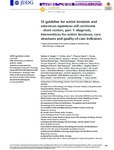S3 guideline for actinic keratosis and cutaneous squamous cell carcinoma – short version, part 1: diagnosis, interventions for actinic keratoses, care structures and quality‐of‐care indicators
Heppt, Markus V.
Leiter, Ulrike
Steeb, Theresa
Amaral, Teresa
Bauer, Andrea
Becker, Jürgen C.
Breitbart, Eckhard
Breuninger, Helmut
Diepgen, Thomas
Dirschka, Thomas
Eigentler, Thomas
Flaig, Michael
Follmann, Markus
Fritz, Klaus
Greinert, Rüdiger
Gutzmer, Ralf
Hillen, Uwe
Ihrler, Stephan
John, Swen Malte
Kölbl, Oliver
Kraywinkel, Klaus
Löser, Christoph
Nashan, Dorothée
Noor, Seema
Nothacker, Monika
Pfannenberg, Christina
Salavastru, Carmen
Schmitz, Lutz
Stockfleth, Eggert
Szeimies, Rolf-Markus
Ulrich, Claas
Welzel, Julia
Wermker, Kai
Berking, Carola
Garbe, Claus
Actinic keratoses (AK) are common lesions in light‐skinned individuals that can potentially progress to cutaneous squamous cell carcinoma (cSCC). Both conditions may be associated with significant morbidity and constitute a major disease burden, especially among the elderly. To establish an evidence‐based framework for clinical decision making, the guideline “actinic keratosis and cutaneous squamous cell carcinoma” was developed using the highest level of methodology (S3) according to regulations issued by the Association of Scientific Medical Societies in Germany (AWMF). The guideline is aimed at dermatologists, general practitioners, ENT specialists, surgeons, oncologists, radiologists and radiation oncologists in hospitals and office‐based settings as well as other medical specialties involved in the diagnosis and treatment of patients with AK and cSCC. The guideline is also aimed at affected patients, their relatives, policy makers and insurance funds. In the first part, we will address aspects relating to diagnosis, interventions for AK, care structures and quality‐of‐care indicators.
Dateien zu dieser Publikation

